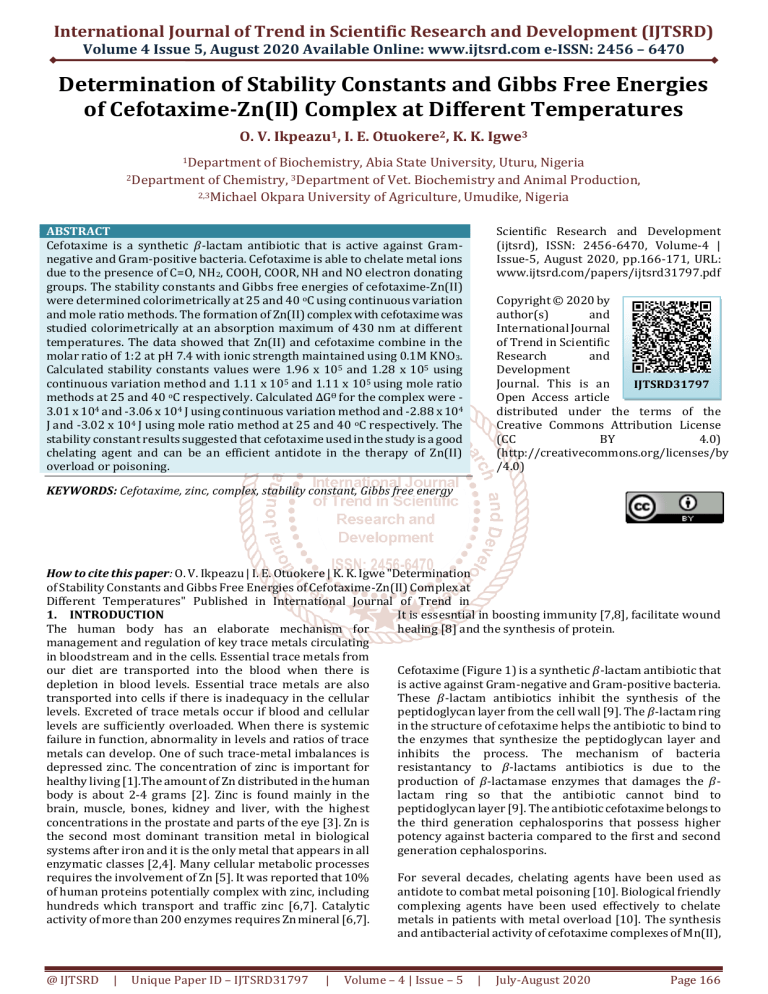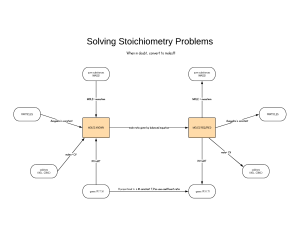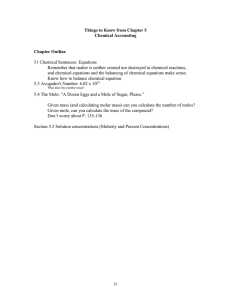
International Journal of Trend in Scientific Research and Development (IJTSRD)
Volume 4 Issue 5, August 2020 Available Online: www.ijtsrd.com e-ISSN: 2456 – 6470
Determination of Stability Constants and Gibbs Free Energies
of Cefotaxime-Zn(II) Complex at Different Temperatures
O. V. Ikpeazu1, I. E. Otuokere2, K. K. Igwe3
1Department
of Biochemistry, Abia State University, Uturu, Nigeria
of Chemistry, 3Department of Vet. Biochemistry and Animal Production,
2,3Michael Okpara University of Agriculture, Umudike, Nigeria
2Department
ABSTRACT
Cefotaxime is a synthetic 𝛽-lactam antibiotic that is active against Gramnegative and Gram-positive bacteria. Cefotaxime is able to chelate metal ions
due to the presence of C=O, NH2, COOH, COOR, NH and NO electron donating
groups. The stability constants and Gibbs free energies of cefotaxime-Zn(II)
were determined colorimetrically at 25 and 40 oC using continuous variation
and mole ratio methods. The formation of Zn(II) complex with cefotaxime was
studied colorimetrically at an absorption maximum of 430 nm at different
temperatures. The data showed that Zn(II) and cefotaxime combine in the
molar ratio of 1:2 at pH 7.4 with ionic strength maintained using 0.1M KNO3.
Calculated stability constants values were 1.96 x 105 and 1.28 x 105 using
continuous variation method and 1.11 x 105 and 1.11 x 105 using mole ratio
methods at 25 and 40 oC respectively. Calculated ∆GƟ for the complex were 3.01 x 104 and -3.06 x 104 J using continuous variation method and -2.88 x 104
J and -3.02 x 104 J using mole ratio method at 25 and 40 oC respectively. The
stability constant results suggested that cefotaxime used in the study is a good
chelating agent and can be an efficient antidote in the therapy of Zn(II)
overload or poisoning.
Scientific Research and Development
(ijtsrd), ISSN: 2456-6470, Volume-4 |
Issue-5, August 2020, pp.166-171, URL:
www.ijtsrd.com/papers/ijtsrd31797.pdf
Copyright © 2020 by
author(s)
and
International Journal
of Trend in Scientific
Research
and
Development
Journal. This is an
IJTSRD31797
Open Access article
distributed under the terms of the
Creative Commons Attribution License
(CC
BY
4.0)
(http://creativecommons.org/licenses/by
/4.0)
KEYWORDS: Cefotaxime, zinc, complex, stability constant, Gibbs free energy
How to cite this paper: O. V. Ikpeazu | I. E. Otuokere | K. K. Igwe "Determination
of Stability Constants and Gibbs Free Energies of Cefotaxime-Zn(II) Complex at
Different Temperatures" Published in International Journal of Trend in
1. INTRODUCTION
It is essesntial in boosting immunity [7,8], facilitate wound
The human body has an elaborate mechanism for
healing [8] and the synthesis of protein.
management and regulation of key trace metals circulating
in bloodstream and in the cells. Essential trace metals from
our diet are transported into the blood when there is
Cefotaxime (Figure 1) is a synthetic 𝛽-lactam antibiotic that
depletion in blood levels. Essential trace metals are also
is active against Gram-negative and Gram-positive bacteria.
transported into cells if there is inadequacy in the cellular
These 𝛽-lactam antibiotics inhibit the synthesis of the
levels. Excreted of trace metals occur if blood and cellular
peptidoglycan layer from the cell wall [9]. The 𝛽-lactam ring
levels are sufficiently overloaded. When there is systemic
in the structure of cefotaxime helps the antibiotic to bind to
failure in function, abnormality in levels and ratios of trace
the enzymes that synthesize the peptidoglycan layer and
metals can develop. One of such trace-metal imbalances is
inhibits the process. The mechanism of bacteria
depressed zinc. The concentration of zinc is important for
resistantancy to 𝛽-lactams antibiotics is due to the
healthy living [1].The amount of Zn distributed in the human
production of 𝛽-lactamase enzymes that damages the 𝛽body is about 2-4 grams [2]. Zinc is found mainly in the
lactam ring so that the antibiotic cannot bind to
brain, muscle, bones, kidney and liver, with the highest
peptidoglycan layer [9]. The antibiotic cefotaxime belongs to
concentrations in the prostate and parts of the eye [3]. Zn is
the third generation cephalosporins that possess higher
the second most dominant transition metal in biological
potency against bacteria compared to the first and second
systems after iron and it is the only metal that appears in all
generation cephalosporins.
enzymatic classes [2,4]. Many cellular metabolic processes
requires the involvement of Zn [5]. It was reported that 10%
For several decades, chelating agents have been used as
of human proteins potentially complex with zinc, including
antidote to combat metal poisoning [10]. Biological friendly
hundreds which transport and traffic zinc [6,7]. Catalytic
complexing agents have been used effectively to chelate
activity of more than 200 enzymes requires Zn mineral [6,7].
metals in patients with metal overload [10]. The synthesis
and antibacterial activity of cefotaxime complexes of Mn(II),
@ IJTSRD
|
Unique Paper ID – IJTSRD31797
|
Volume – 4 | Issue – 5
|
July-August 2020
Page 166
International Journal of Trend in Scientific Research and Development (IJTSRD) @ www.ijtsrd.com eISSN: 2456-6470
Fe(II), Co(II), Ni(II), Cu(II) and Cd(II) (Figure 2) have also
been reported [11]. Many authours have reported the study
of stability constant of drug- metal complexes [12 – 14].
However, to the best of authors knowledge, stability
constants and Gibbs free energies of cefotaxime – Zn(II)
complex at different temperatures have yet not appeared in
the literature. These stability constants are useful to study
the effects of cefotaxime on trace elements and mineral
metabolism. It is possible that changes in trace element and
mineral concentration induced by cefotaxime can be an
efficient antidote in the therapy of zinc overload or
poisoning. In this context, the aim of this study was to assess
stability constants and free energy change of cefotaximeZn(II) complex at 25 and 40 oC respectively.
2.5. Procedure for continuous variation method
ZnCl2 (2 x 10-2 M) (0, 1,2, 3, 4, 5, 6 cm3) was pippeted out and
transferred into seven 50 cm3 volumetric flasks. Cefotaxime
(2 x 10-2 M) (6, 5, 4, 3, 2, 1, 0 cm3) was added, respectively to
the Zn(II) solution so that the mole fraction remained
constant. The pH adjusted to 7.4 and ionic strength
maintained constant by using 0.1 M KNO3. Their absorbance
were measured at 430 nm (maximum absorbance of the
complex) and at a temperature of 25 and 40 oC, respectively.
2.6. Procedure for mole ratio method
ZnCl2 (2 x 10-2 M) (2 cm3) was pippeted out and transferred
into each of the seven 50 cm3 volumetric flasks. Cefotaxime
(2 x 10-2 M) (1, 2, 3, 4, 5, 6, 7 cm3) was added to each of the
Cu(II) solution respectively. Wavelength of maximum
absorbance of the complex (430 nm) was noted against
blank reagent CuSO4. Their absorbance was measured at 430
nm and at a temperature of 25 and 40 oC, respectively.
2.7.
Calculation of stoichiometry mole fraction,
stability constant and free energy
The stoichiometry mole fraction (SMF) of the complex using
continuous variation method was calculated using equation
1 [15].
Figure 1: Chemical structure of cefotaxime
Where m is the mole fraction of metal ion.
Equation 2 [15] was applied to the calculation of stability
constant.
Where C is the concentration of the complex at stoichiometry
point, α is the degree of dissociation, m and n are the
corresponding stoichiometric coefficients of metal and
ligand respectively.
Figure 2: Tentative structure of cefotaxime metal
complexes, M = Mn(II), Co(II), Ni(II), Cu(II) and Cd(II)
The degree of dissociation (α) was calculated using
equations 3, 4 and 5 [15].
2. Materials and methods
2.1. Instrumentation
Absorbances were measured using auto colorimeter ME-51.
Orion Versa Star Pro pH Benchtop meter (VSRAR10 series)
was used for pH measurements.
2.2. 2.2 Reagents
All the chemicals used were of analytical grade purity.
Cefotaxime was purchased from Nitin Life sciences Limited,
Indian. ZnCl2 was purchased from Merck Germany. Doubledistilled water was used throughout the experiment.
Where
2.3. Preparation of 2 x 10-2 M ZnCl2
ZnCl2 (2.73 g, 20 Mmol, M. Wt. = 136.29 g/mol) was
dissolved in freshly distilled in a 250 cm3 beaker and was
made up to the mark in a 1000 cm3 volumetric flask.
dissociated concentration of complex.
is molar
absorptivity, b is cell thickness, C is a concentration of
complex at stoichiometry point.
2.4. Preparation of 2 x 10-2 M cefotaxime
Cefotaxime (9.1094 g, 20 Mmol, M. Wt. = 455.47 g/mol) was
dissolved in freshly distilled in a 250 cm3 beaker and was
made up to the mark in a 1000 cm3 volumetric flask.
@ IJTSRD
|
Unique Paper ID – IJTSRD31797
|
is absorbance value of the maximum at
experimental curve that represents the maximum quantity of
the complex that is formed.
is absorbance value
corresponding to the intersect point of the theoretical
straight lines.
is the absorbance value of the part of
The Gibbs free energy was calculated using equation 6.
Volume – 4 | Issue – 5
|
July-August 2020
Page 167
International Journal of Trend in Scientific Research and Development (IJTSRD) @ www.ijtsrd.com eISSN: 2456-6470
3. Results and discussion
The electronic spectra of cefotaxime-Zn(II) complex is shown in Figure 3.
Figure 3: Absorption spectra of ZnCl2 (2 x 10-2 M) (series 1) and cefotaxime-Zn(II) complex (2 x 10-2 M) (series 2)
The electronic spectra were measured from 400 – 670 nm. The electronic spectrum of cefotaxime-Zn(II) complex showed λ
maximum at 430. At the wavelength, ZnCl2 have a weak absorbance. Therefore, this wavelength was used for the measurement
of absorbance in the determination of the stability constants and free energies. ZnCl 2 absorbs maximally at wavelength of 400
nm. It was observed that cefotaxime-Zn(II) complex gave a white, water soluble complex. In aqueous solution, zinc-aquo
complex is a labile complex because water behaved as a weak ligand. Cefotaxime displaced water from zinc-aquo to form a
stable cefotaxime - Zn(II) complex. Similar labile aquo complexes were also reported by Tirmizi and co-workers in their study
of famotidine-Cu complex and cimetidine-Ni complex [13, 14]. Tella and co–workers reported labile aquo complex in their
study of Dapsone-Cu(II) stability constants [10].
Table 1: Experimental data of cefotaxime-Zn(II) complex at 430 nm by continuous variation method
Absorbance at 430 nm
ZnCl2
Cefotaxime
S/N
Mole fraction of Zn(II)
(2 x 10-2 M) (2 x 10-2 M)
25 ℃
40 ℃
@ IJTSRD
|
1
2
3
4
5
6
0.00
1.00
2.00
3.00
4.00
5.00
6.00
5.00
4.00
3.00
2.00
1.00
0.00
0.17
0.33
0.50
0.66
0.83
0.00
0.05
0.22
0.41
0.50
0.18
0.00
0.04
0.21
0.42
0.50
0.19
7
6.00
0.00
1.00
0.06
0.09
Unique Paper ID – IJTSRD31797
|
Volume – 4 | Issue – 5
|
July-August 2020
Page 168
International Journal of Trend in Scientific Research and Development (IJTSRD) @ www.ijtsrd.com eISSN: 2456-6470
0.6
Absorbance
0.5
0.4
0.3
0.2
0.1
0
0
0.2
0.4
0.6
0.8
1
1.2
Mole fraction of Zn(II)
Figure 4: Job’s curves for stability constants of equimolar solutions at 25 oC
0.6
Absorbance
0.5
0.4
0.3
0.2
0.1
0
0
0.2
0.4
0.6
0.8
1
1.2
Mole fraction of Zn(II)
Figure 5: Job’s curves for stability constants of equimolar solutions at 40 oC
The extrapolated value at the point of cross-section on continuous variation plot (Figures 4 and 5) corresponded to the total
absorbance of the complex, indicating that the complex formation process has been completed. The mole fraction of Zn(II) at
the point of intersection are 0.64 and 0.63 at 25 and 40 0C respectively. Application of equation 1, yields SMF of 1.77 (≈ 2) and
1.70 (≈ 2) at 25 and 40 0C respectively. This corresponded to metal:ligand ratio of 1:2. This is in agreement with the report of
Reiss and co-workers [9] where 1:2 metal:ligand ratio was proposed for Zn (II) complexes with cefotaxime-derived Schiff base.
Table 2: Experimental data of cefotaxime-Zn(II) complex at 430 nm by mole ratio method
Absorbance at 430 nm
ZnCl2
Cefotaxime
S/N
Vol of Cefotaxime/ vol of Zn(II)
(2 x 10-2 M) (2 x 10-2 M)
25 ℃
40 ℃
@ IJTSRD
|
1
2
3
4
5
2.00
2.00
2.00
2.00
2.00
1.00
2.00
3.00
4.00
5.00
0.5
1.0
1.5
2.0
2.5
0.20
0.42
0.49
0.49
0.48
0.20
0.42
0.49
0.49
0.48
6
7
2.00
2.00
6.00
7.00
3.0
3.5
0.47
0.46
0.47
0.47
Unique Paper ID – IJTSRD31797
|
Volume – 4 | Issue – 5
|
July-August 2020
Page 169
International Journal of Trend in Scientific Research and Development (IJTSRD) @ www.ijtsrd.com eISSN: 2456-6470
0.6
Absorbance
0.5
0.4
0.3
0.2
0.1
0
0
0.5
1
1.5
2
2.5
3
3.5
4
Vol. of cefotaxime/vol. of Zn(II)
Figure 6: Mole ratio method curves for stability constant at 25 oC
0.6
Absorbance
0.5
0.4
0.3
0.2
0.1
0
0
0.5
1
1.5
2
2.5
3
3.5
4
Vol. of cefotaxime/vol. of Zn(II)
Figure 7: Mole ratio method curves for stability constant at 40 oC
The metal:ligand ratio of the complex was evaluated from the point where this curve changes its slope. The extrapolated value
at the point of cross-section on mole ratio plot (Figures 6 and 7) corresponded to the total absorbance of the complex,
indicating that the complex formation process has been completed. The vol. of cefotaxime/vol. of Zn(II) at the point of
intersection are 1.5 ≈ 2.0 and 1.5 ≈ 2.00 at 25 and 40 0C respectively. This corresponded to metal:ligand ratio of 1:2. This was in
agreement with the proposed structure reported in literature [9].
S. No
1
2
Table 3: Calculated stability constant values and ∆GƟ for cefotaxime-Zn complex
Stability constant (log K)
∆GƟ (J)
Method
Metal: ligand ratio
o
o
o
25 C
40 C
25 C
40 oC
Continuous variation
1:2
1.96 x 105
1.28 x 105 -3.01 x 104 -3.06 x 104
Mole ratio
1:2
1.11 x 105
1.11 x 105 -2.88 x 104 -3.02 x 104
The stability constant values showed that the complex was stable both at room temperature and higher temperature. The
values of the stability constants obtained from continuous variation compared well with that of mole ratio method. It can be
seen from the Table 3 that the values obtained by both methods are in fair agreement. Increasing the temperature of
complexation form 25 to 40 oC had no effect on the stability constant. The values of the stability constants were positive, this
suggested that the complex was stable. Similar positive values of stability constant of complexes were reported by Tirmizi and
co-workers [13, 14] using continuous variation and mole ratio methods. Waranyoupalin and co-workers also reported positive
@ IJTSRD
|
Unique Paper ID – IJTSRD31797
|
Volume – 4 | Issue – 5
|
July-August 2020
Page 170
International Journal of Trend in Scientific Research and Development (IJTSRD) @ www.ijtsrd.com eISSN: 2456-6470
stability constant values using continuous variation and mole ratio methods [16]. The results of stability constant suggested
that cefotaxime could be effective in chelation therapy against Zn(II) toxicity. The negative values of the free energies suggested
that the complexes were formed spontaneously. Both Job’s and mole ratio methods supported the metal to ligand ratio of 1:2 as
evidenced from the results obtained by Reiss and co-workers [9].
Conclusion
Cefotaxime is a third generation cephalosporin. It formed a
reasonably stable complex with Zn(II). Job’s method of
analysis corresponded well with the values obtained using
mole ratio method of analysis. The Job’s continous variation
and mole ratio methods data showed that Zn(II) and
cefotaxime combine in the molar ratio of 1:2. The stability
constant results suggested that cefotaxime used in the study
is a good chelating agent and can be an efficient antidote in
the therapy of Zn(II) overload or poisoning.
References
[1] Kaslow JE. Copper/Zinc Imbalance. Medical Board of
California.
[2] R. A. Wapnir, “Protein Nutrition and Mineral
Absorption”, CRC Press. 1990
[3] C. C. Pfeiffer & E. R. Braverman. “Zinc, the brain and
behavior”, Biol Psychiatry , Vol. 17, pp. 513, 1982
[4] M. R. Broadley, P. J. White, J. P. Hammond, I. Zelko & A.
Lux, “Zinc in plants. New Phytologist”, Vol. 173, pp.
677, 2007
[5] H. G. Classen, U. Gröber, D. Löw, J. Schmidt & H. Stracke
“Zinc deficiency: Symptoms, causes, diagnosis and
therapy. Med Monatsschr Pharm, Vol. 34, pp. 87, 2001
[6] H. H. Sandstead, “Understanding zinc: recent
observations and interpretations”, J Lab Clin Med, Vol.
124, pp. 322, 1994
[7] T. J. McCarthy, J. J. Zeelie & D. J. Krause, “The
antimicrobial action of zinc ion/antioxidant
combinations”, Clinical Pharmacology & Therapeutics
Vol. 17, pp. 5,1992
[8] N. W. Solomons, “Mild human zinc deficiency produces
an imbalance between cell-mediated and humoral
immunity”, Nutr Rev, Vol. 56, pp. 27, 1998
[9] A. Reiss, M. C. Chifiriuc, E. Amzoiu & C. I. Spînu,
“Transition Metal(II) Complexes with CefotaximeDerived Schiff Base: Synthesis, Characterization, and
@ IJTSRD
|
Unique Paper ID – IJTSRD31797
|
Antimicrobial Studies”, Bioinorganic Chemistry and
Applications, Vol. 2014, pp. 17, 2014
[10] A.C. Tella, & J. A. Obaleye, “Metal-Chelator Therapy:
Stability Constatnt of Transition metal complexes of
Pyrimidine and Sulphonamide Drugs. Int. Chem. Sci. 8,3
(2010)1675
[11] J. R. Anacona, & G. D. Silva, “Synthesis and antibacterial
activity of cefotaxime metal complexes”, Journal of
Chilean Chemical Society, Vol. 50, 2, pp. 447, 2005
[12] M. Reková, P. Vanura & V. Jedináková-Krízová,
“Determination of Protonation Constants and Stability
Constants of Lanthanides with Derivative of H4DOTA
Complexes by the UV-VIS Spectrophotometry and
Potentiometry”, The Open Inorganic Chemistry Journal,
Vol. 3, pp. 26, 2009
[13] S. A.Tirmizi, M. H. Sarwar, W. S. Sarwar & W. Anwar,
“Spectrophotometric study of stability constants of
famotidine-Cu(II) complex at different temperatures” ,
The Arabian Journal for Science and Engineering, Vol.
34, 2A, pp. 43, 2008
[14] S. A. Tirmizi, F. H. Wattoo, M. H. S. Wattoo, S. Sarwar,
A.N. Memon & A.B. Ghangro, “Spectrophotometric
study of stability constants of cimetidine–Ni(II)
complex at different temperatures”, Arabian Journal of
Chemistry, Vol. 5, pp. 309, 2012
[15] R. F. Abbas (2017). Spectrophotometric determination of
stability constant by classical and Modified Varagas
equations for procaine penicillin G using diazotization
reaction depending on stoichiometric curves,
International Journal of ChemTech Research, Vol. 10, No
2, pp. 485 – 496.
[16] R. Waranyoupalin, S. Wongnawa, M. Wongnawa, C.
Pakawatchai, P. Panichayupakaranant & P.
Sherdshoopongse , “Studies of complex formation
between curcumin and Hg(II) by spectrophotometric
method: A new approach to overcome peak overlap”,
Cent. Eur. J. Chem. Vol. 7, No. 3 pp. 388, 2009
Volume – 4 | Issue – 5
|
July-August 2020
Page 171





